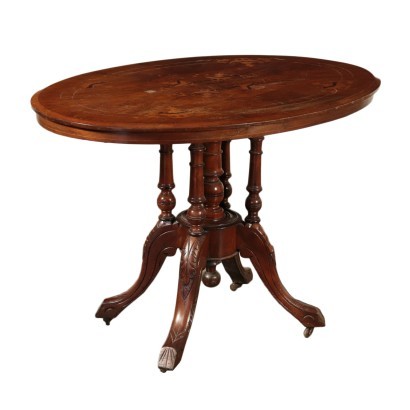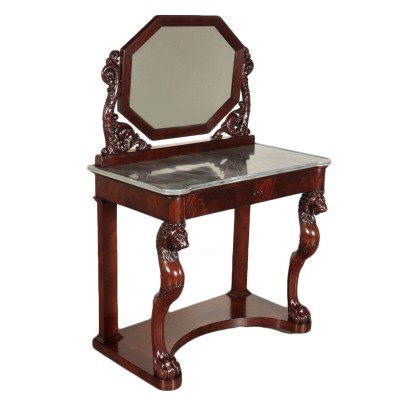Victorian Sailing Table Walnut and Marple Englad 19th Century
Features
Style: Victorian (1830-1900)
Age: 19th Century / 1801 - 1900
Origin: England
Description
Walnut sailing table of English production.; supported by a central refined baluester and by 4 refined supports that lean angaist 4 curved and engraved legs with wheels, Top with marple inlays shaped as vases with phitomorphic scrolls.
Product Condition:
Fair condition. Wear consistent with age and use.
Dimensions (cm):
Height: 73
Width: 103,5
Depth: 71,5
Additional Information
Style: Victorian (1830-1900)
This refers to one of the predominant styles used during the Victorian era.Like the latter, it roughly refers to the duration of the reign of Queen Victoria (20 June 1837 - 22 January 1901), from which it took its name.
Characterized by a great expansion of the home furnishing market and by new mechanized production possibilities, but not by great aesthetic innovations, but by the revival of stylistic elements from various previous eras.
Find out more about the Victorian style with our insights:
Writing desk, Arthur Blain, Liverpool c. 1840
Age: 19th Century / 1801 - 1900
19th Century / 1801 - 1900Main essence:
Maple
Hard, light wood used for inlays. It grows mainly in Austria, but it is widespread throughout the northern hemisphere, from Japan to North America, passing through China and Europe. It is one of the lightest woods ever, tending to white, it is similar to lime or birch wood. The briar is used in the production of ancient secretaires .Walnut
Walnut wood comes from the plant whose botanical name is juglans regia , probably originally from the East but very common in Europe. Light or dark brown in color, it is a hard wood with a beautiful grain, widely used in antique furniture. It was the main essence in Italy throughout the Renaissance and later had a good diffusion in Europe, especially in England, until the advent of mahogany. It was used for solid wood furniture and sometimes carvings and inlays, its only big limitation is that it suffers a lot from woodworm. In France it was widely used more than anything else in the provinces. In the second half of the eighteenth century its use decreased significantly because mahogany and other exotic woods were preferred. Alternative proposals



























